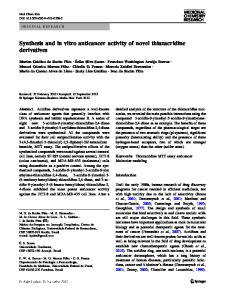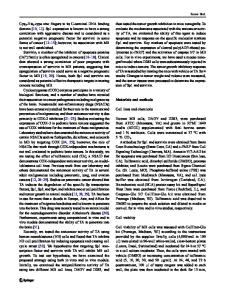Enhanced anticancer activity and endocytic mechanisms by polymeric nanocarriers of n -butylidenephthalide in leukemia ce
- PDF / 1,453,005 Bytes
- 10 Pages / 595.276 x 790.866 pts Page_size
- 108 Downloads / 328 Views
RESEARCH ARTICLE
Enhanced anticancer activity and endocytic mechanisms by polymeric nanocarriers of n‑butylidenephthalide in leukemia cells X.‑F. Huang1,2 · P.‑T. Chen3 · Y.‑L. Lin4 · M.‑S. Lee2,3 · K.‑F. Chang1,2 · K.‑W. Liao5,6 · G.‑T. Sheu1 · M.‑C. Hsieh2,3 · N.‑M. Tsai2,3 Received: 6 July 2020 / Accepted: 15 September 2020 © Federación de Sociedades Españolas de Oncología (FESEO) 2020
Abstract Purpose The purpose of this study was to investigate the antitumor mechanisms of n-butylidenephthalide (BP) and to further examine the delivery efficacy of polycationic liposome containing PEI and polyethylene glycol complex (LPPC)-encapsulated BP in leukemia cells. Methods MTS, flow cytometric and TUNEL assays were performed to assess cell viability and apoptosis. BP and BP/LPPC complex delivery efficiency was analyzed by full-wavelength fluorescent scanner and fluorescence microscope. The expressions of cell cycle- and apoptosis-related proteins were conducted by Western blotting. Results The results showed that BP inhibited leukemia cell growth by inducing cell cycle arrest and cell apoptosis. LPPCencapsulated BP rapidly induced endocytic pathway activation, resulting in the internalization of BP into leukemia cells, causing cell apoptosis within 1 h. Conclusions LPPC encapsulation enhanced the cytotoxic activity of BP and did not influence the effects of BP induction that suggested LPPC-encapsulated BP might be developed as anti-leukemia drugs in future. Keywords Leukemia · Polycationic liposome containing PEI and polyethylene glycol complex (LPPC) · n-Butylidenephthalide (BP) · Cell apoptosis · Cell cycle
Introduction
M.-C. Hsieh and N.-M. Tsai contributed equally to this work. * N.‑M. Tsai [email protected] 1
Institute of Medicine, Chung Shan Medical University, Taichung 40201, Taiwan, ROC
2
Department of Medical Laboratory and Biotechnology, Chung Shan Medical University, Taichung 40201, Taiwan, ROC
3
Clinical Laboratory, Chung Shan Medical University Hospital, Taichung 40201, Taiwan, ROC
4
Agricultural Biotechnology Research Center, Academia Sinica, Taipei 11529, Taiwan, ROC
5
Department of Biological Science and Technology, National Chiao Tung University, Hsinchu 30010, Taiwan, ROC
6
Institute of Molecular Medicine and Bioengineering, National Chiao Tung University, Hsinchu 30010, Taiwan, ROC
Acute myeloid leukemia (AML) is a heterogeneous disorder characterized by altering the normal mechanisms of self-renewal, proliferation, and differentiation in immature hematopoietic progenitor cells [1, 2]. Overall survival (OS) decreases with increasing age; people whose age ranges from 18 to 60 have an OS rate of 45–50%, and those older than 60 have an OS rate of 3–8% [2, 3]. Outcomes for older adults with AML are poor because older patients are more likely to express multidrug-resistant proteins, making these patients more resistant to chemotherapy and partially attributable to excess toxicity from chemotherapy [4–8]. Hence, there remains an urgent need for novel therapeutic agents that are
Data Loading...











